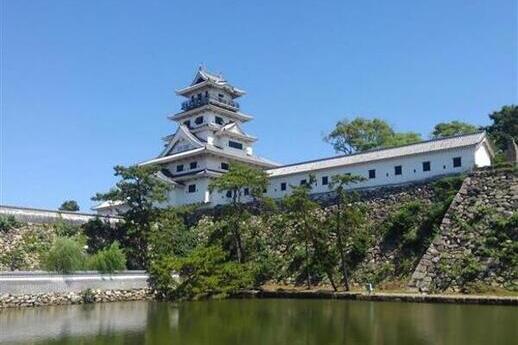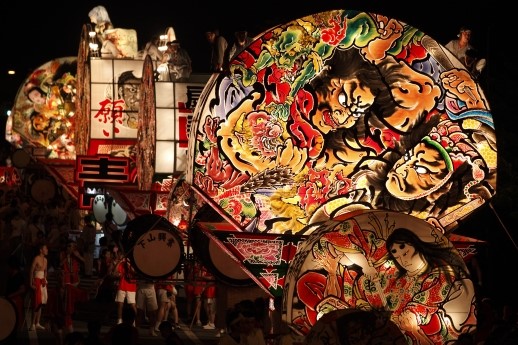2025.07.31
伝検通信(メルマガ)週刊メールマガジン「伝検通信」 第68号
週刊メールマガジン「伝検通信」第68号をお届けします。
今週のトップ記事は、白洲信哉さんの「多様なるジャパン」です。藍にまつわる話題をお伝えします。
「クイズで肩慣らし」は、前回クイズの答え・解説と、「建築」の問題です。
第2回伝検は現在実施中で、こちらから申し込みを受け付けていま
伝検公式教材・参考書・サイト https://denken-test.jp/
目次
・ 「多様なるジャパン」 第9回 藍染
・ 「クイズで肩慣らし」 第67回=「建築」
・ 伝検協会だより
「多様なるジャパン」 第9回 藍染
白洲信哉=文筆家、日本伝統文化検定協会副会長

藍染の暖簾「市女笠」(筆者蔵)
藍は夏の色。わが国有数の藍の原産地阿波(徳島県)では、ツバメの帰りを待って種蒔(ま)きが始まり、梅雨明けとともに成長した藍の葉を摘み乾燥させ、蒅(すくも)の元になる葉藍に仕上げる。生の葉染めは夏限定の仕事だ。だが、藍という名の植物はなく、葉にインジカンと言う色素を含んでいれば全て藍染の材料となり、各地の気候風土にあった多岐にわたる「藍」が太古から地球上のいたるところにある。藍のあるところに人間の生活があり、薬にはじまり藍の葉による染色は世界を巡ってきた。
明治初めに来日した東大初のお雇い教師は「日本においては藍を染料となして、これを使用するのが大変多い。日本に来て全国至る所で藍色の衣装を見る」(藍の説)と記し、かの小泉八雲も「青い暖簾(のれん)をした店も小さく、青い着物を着て笑っている人も小さいのだった」(知られぬ日本の面影)とジャパンブルーやヒロシゲブルーと言う新語が生まれるほど、一般庶民の着物、浴衣、半纏(はんてん)、作務衣(さむえ)、暖簾、風呂敷、幟(のぼり)旗など江戸以降の藍は生活必需品だった。
だが、ひとくちに藍色と言っても淡い青色から紺色に近い濃いものまで多くの段階があり、微妙な濃淡から「藍四十八色」とも言われ、甕覗(かめのぞ)き、空色、浅葱(あさぎ)、縹(はなだ)、紺、搗(かち)色など淡ければ優しく、濃ければ逞(たくま)しくそれぞれ情感を刺激してくれる。中国の古い諺(ことわざ)に「青は藍より出でて、藍より青し」と言うように「それはもう何百種類もの違う色になるので、藍ほどかぎりなく深く、面白いものはない」と昨年百寿を迎えられた染織家志村ふくみさんの言葉を白洲正子は書き残している(日本のたくみ)。藍は他の植物染料と違って特定の温度で発酵を続ける菌(藍華)で、「建てる」のである。
NHK朝ドラのモデルにもなった牧野富太郎博士によると、生藍の葉や種子の生汁など消炎、解毒剤、止血、虫刺され、痔疾(じしつ)など効能を記し扁桃(へんとう)炎、喉頭炎などに効果があり、マムシやムカデにクマなどが出る山で暮らす人々には欠かせない薬草でもあったという。中世武家の世になり先に記した搗色の音に縁起を担いだと言うが、戦場での止血など実用的な薬でもあったのだ。
僕は自宅の各所に藍染の暖簾をかけている。ここで暖簾について述べる紙幅はないが、連載5回目の根来と同じように染物も大事なのは素地だと思う。伊豆大島に住む旧知の菅原匠さんの作品は、榀布(しなふ)と言う誠に堅牢(けんろう)な織物に染め上げた単純な図柄が季節のうつろいに一役かっている。
「クイズで肩慣らし」 第67回=「建築」
~伝統文化に関するさまざまな話題をクイズ形式でお届けします~

瀬戸内海に面した海岸に築かれた今治城、別名、吹揚城(ふきあげじょう)
第67回
問題:秀吉、秀長兄弟の豊臣家や徳川家康らに仕え、赤木城(三重県)、今治城(愛媛県)、篠山城(兵庫県)など生涯で20を超える城を築城・修築し、「築城の名人」として知られる戦国武将は誰でしょう。(答えと解説は次号で)

青森の夏の風物詩、ねぶた(ねぷた)祭り
【前回の問題と答え・解説】
問題:毎年8月上旬に行われる青森県のねぶた祭。青森ねぶたはねぶたを引くときに「ラッセラー」、五所川原立佞武多(ごしょがわらたちねぷた)では「ヤッテマレ」という掛け声を発します。では、弘前ねぷたはどんな掛け声でしょう。
答え:ヤーヤドー
解説:ねぶた(ねぷた)祭は青森県の各地で行われており、巨大な灯籠を山車に乗せて街中を練り歩きます。祭りの起源は、奈良時代の七夕祭りの灯籠流しが変形したという説や、弘前藩の初代藩主・津軽為信が豊臣秀吉に「津軽の大灯籠」を披露した史実から始まったなど諸説あります。青森市のものが「東北三大祭り」に数えられて特に有名ですが、各地で灯籠の形や掛け声などが異なります。「ヤーヤドー」というのは、ねぷた歌の中の「いやいやいやよ」という歌詞が変化したものとか、ねぷた喧嘩(けんか)が激しかったころの怒号の名残から来ているといわれています。
伝検協会だより
▼協会会員の三菱UFJフィナンシャル・グループが取り組む伝統工芸・産業の支援事業、「MUFG工芸プロジェクト」。その一環として実施している若手作家による「KOGEI ARTISTS LEAGUE」でファイナリストに選考された22人の作品を紹介するトークイベント「未来へ向かう工芸」が8月19日(火)午後、東京・日本橋で開かれます。選考委員を務めた工芸作家やファイナリストと対話ができるコーナーも用意されます。その翌20日(水)から25日(月)には、東京・日本橋三越本店で選考作品などの展示販売会が開催されます。トークイベント観覧希望の方は下記をご覧ください。
KOGEI ARTISTS LEAGUE
トークプログラム 参加申し込みフォーム
【編集後記】
第2回伝検が残り2週間ほどとなりました。第1回伝検では10代から70代までの幅広い方が受験し、多くの合格者が出ています。合格の喜びの声では「社内の評価制度に入ったから」「日本の文化に関心があったので」とさまざまな受験のきっかけが語られています。コンピューターを活用した検定のため、その場で結果が分かります。ぜひチャレンジしてみてください。
詳細は公式サイトの過去検定情報をご覧ください。
【English version】
Weekly e-newsletter Denken Tsushin, No. 68.
We are pleased to deliver the 68th issue of the weekly email magazine ‘Denken News.’
This week's top article is ‘Diverse Japan’ by Shinya Shirasu. We will share topics related to indigo.
“Let's Practice with Quizzes” features the answers and explanations to the previous quiz, as well as a question on ‘architecture.’
The second Denken exam is currently underway, and applications are being accepted here. There are only two weeks remaining. Please make use of the official textbook and online lectures below and give it a try.
Denken Official Textbooks, Reference Books, and Website: https://denken-test.jp/official_text/
Table of Contents
・ ‘Diverse Japan’ Part 9: Indigo Dyeing
・ “Let's Practice with Quizzes” Part 67: Architecture
・ News from the Denken Association
‘Diverse Japan’ Part 9: Indigo Dyeing
Shinya Shirasu = Writer, Vice President of the Japan Traditional Culture Certification Association

Indigo-dyed noren curtain, ‘Ichijo-gasa’ (author's collection)
Indigo is the colour of summer. In Awa (Tokushima Prefecture), one of Japan's leading indigo-producing regions, seed sowing begins after the swallows return, and once the rainy season ends, the grown indigo leaves are picked, dried, and processed into leaf indigo, which is used to make sukumo. Fresh leaf dyeing is a summer-only task. However, there is no plant called ‘indigo,’ and any plant containing the pigment indican in its leaves can be used as material for indigo dyeing. Thus, various forms of ‘indigo’ suited to local climates and environments have existed since ancient times across the globe. Where there is indigo, there is human life, and its use has spread worldwide, from medicine to dyeing with indigo leaves.
The first hired teacher at the University of Tokyo, who came to Japan at the beginning of the Meiji era, wrote, ‘In Japan, indigo is used as a dye in a great many ways. Upon arriving in Japan, I saw indigo-coloured clothing everywhere’ (The Theory of Indigo). Lafcadio Hearn also wrote, ‘The shops with blue curtains were small, and the people wearing blue kimonos and smiling were also small.’ (The Unknown Face of Japan). The term ‘Japan Blue’ or ‘Hiroshige Blue’ was coined, reflecting how indigo became an essential part of daily life for the common people in garments such as kimonos, yukatas, hanten, samue, noren, furoshiki, and nobori flags from the Edo period onwards.
However, when it comes to indigo blue, there are many shades ranging from pale blue to deep indigo, and the subtle variations in hue led to the term ‘48 shades of indigo.’ These include Kamenozoki, Sorairo, Asagi, hanada, kon, and kachi-iro. Lighter shades evoke a gentle feeling, while darker shades evoke a robust feeling, each stimulating different emotions. As the old Chinese proverb says, ‘Blue comes from indigo, but it is bluer than indigo,’ and as Shimizu Fukumi, a dyeing and weaving artist who celebrated her 100th birthday last year, once said, ‘There are hundreds of different shades, and nothing is as deeply fascinating as indigo,’ as recorded by Shiraishi Masako (Japanese Crafts). Unlike other plant dyes, indigo is ‘cultivated’ using a specific type of bacteria (indigo bacteria) that continues to ferment at a certain temperature.
According to Dr. Tomitaro Makino, who served as a model for an NHK morning drama, the fresh juice from indigo leaves and seeds has anti-inflammatory, detoxifying, haemostatic, and insect bite-relieving properties, and is effective for tonsillitis and laryngitis. It was also an indispensable medicinal herb for people living in mountainous areas where snakes, centipedes, and bears are found. In the medieval samurai era, it was said to bring good luck due to the sound of pounding indigo, but it was also a practical medicine for stopping bleeding on the battlefield.
I have indigo-dyed curtains hanging in various places around my home. While there is not enough space here to discuss curtains in detail, I believe that, like the root of the plant mentioned in the fifth instalment of this series, the base material is crucial in dyeing. The works of my old friend Sugao Sugawara, who lives on Izu Oshima Island, feature simple patterns dyed on shinafu, a remarkably durable fabric, which play a role in marking the changing seasons.
“Let's Practice with Quizzes” No. 67 = ‘Architecture’
~We present various topics related to traditional culture in quiz format~

Imabari Castle, also known as Fukiage Castle, was built on the coast facing the Seto Inland Sea.
No. 67
Question: Who is the warlord known as the ‘master castle builder’ who served the Toyotomi clan of Hideyoshi and Hidenaga and Tokugawa Ieyasu, and built or renovated more than 20 castles throughout his life, including Akagi Castle (Mie Prefecture), Imabari Castle (Ehime Prefecture), and Sasayama Castle (Hyogo Prefecture)? (The answer and explanation will be in the next issue.)

Aomori's summer tradition, the Nebuta (Neputa) Festival
[Previous question and answer/explanation]
Question: The Nebuta Festival is held in Aomori Prefecture every year in early August. During the Aomori Nebuta Festival, participants shout ‘Rassera’ as they pull the floats, while participants in the Goshogawara Tachineputa Festival shout ‘Yattemare.’ What is the chant used in the Hirosaki Nebuta Festival?
Answer: Ya-ya-do
Explanation: The Nebuta (Neputa) Festival is held in various locations throughout Aomori Prefecture, where giant lanterns are placed on floats and paraded through the streets. The origins of the festival are unclear, with theories ranging from it being a variation of the Tanabata Festival lantern floating ceremony from the Nara period to it beginning with the historical fact that the first lord of the Hirosaki domain, Tsugaru Tamenobu, presented ‘Tsugaru's Great Lantern’ to Toyotomi Hideyoshi. The festival in Aomori City is particularly famous as one of the ‘Three Great Festivals of Tohoku,’ but the shapes of the lanterns and the chants vary by region. “Yayado” is said to have originated from the lyrics ‘Iya Iya Iya Yo’ in the Nebuta song or from the remnants of angry shouts during the intense Nebuta fights of the past.
Newsletter from the Traditional Crafts Association
▼Mitsubishi UFJ Financial Group, a member of the association, is engaged in a project to support traditional crafts and industries called the ‘MUFG Crafts Project.’ As part of this project, a talk event titled ‘Crafts for the Future’ will be held on the afternoon of Tuesday, 19 August, in Nihonbashi, Tokyo, to introduce the works of 22 finalists selected by young artists participating in the ‘KOGEI ARTISTS LEAGUE.’ A section where attendees can engage in dialogue with craft artists who served as selection committee members and the finalists will also be available. From the following day, 20th (Wed), to 25th (Mon), an exhibition and sale of selected works will be held at the Nihonbashi Mitsukoshi Main Store in Tokyo. Those interested in attending the talk event are invited to review the details below.
KOGEI ARTISTS LEAGUE
Talk Programme Participation Application Form
[Editor's Note]
The second Denken exam is just two weeks away. The first Denken exam was taken by a wide range of people in their teens to 70s, and many passed. Among the voices of joy from those who passed, there were various reasons for taking the exam, such as ‘I entered the company's evaluation system’ and ‘I was interested in Japanese culture.’ Since this is a computer-based exam, you can find out your results on the spot. Please give it a try.
For details, please see the past exam information on the official website.
カテゴリー: 伝検通信(メルマガ)





